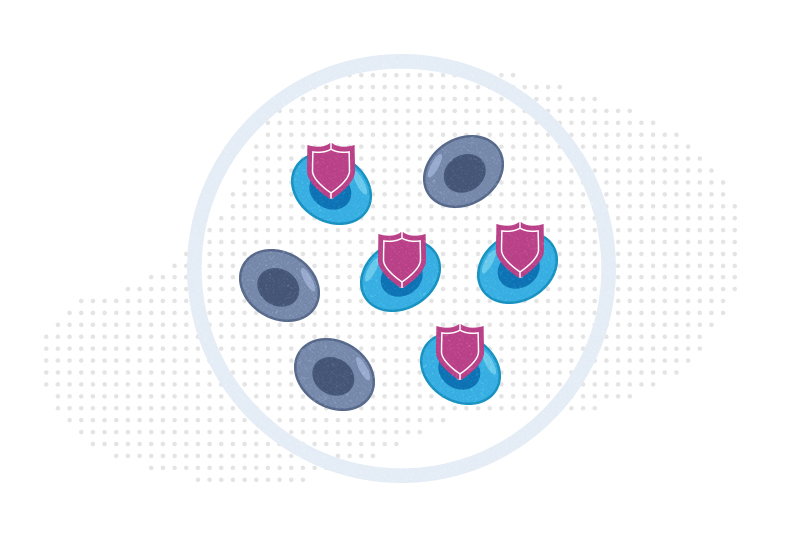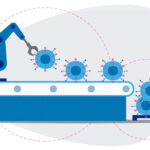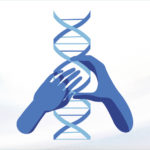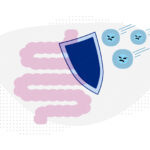Making immunotherapy safe for AML

Acute myeloid leukemia (AML), the second most common leukemia in children, is hard to treat and has a five-year survival rate of just 65 to 70 percent, according to the American Cancer Society. While immunotherapies like monoclonal antibodies or CAR T-cell therapy are effective for certain blood cancers, they have not been possible in AML because of toxicity concerns. It’s been hard to find targets on leukemia cells that normal blood stem cells don’t share, so immunotherapy runs the risk of harming normal cells.
“The problem is that there are no targets for immunotherapy that are specific for the leukemia,” says Pietro Genovese, PhD, a researcher in the Gene Therapy Program at Boston Children’s Hospital and the Dana-Farber/Boston Children’s Cancer and Blood Disorders Center. “There’s no way to discriminate between healthy cells and leukemic cells.”
But what if the healthy cells could be shielded to avoid this toxicity? Genovese and his colleagues describe such a strategy in Nature. They envision using it together with bone marrow transplantation for children with refractory or relapsed AML.
“We decided to engineer the stem cells being transplanted to make them invisible to the immunotherapy,” Genovese says.
Eliminating the leukemia, sparing healthy cells
The researchers selected three immunotherapy targets (FLT3, CD123 and KIT), proteins on the surface of leukemia cells that are essential to their survival. They then turned to normal blood stem cells. Using base editing, they swapped in new amino acids in the genes encoding the same proteins. The subtle change made cancer immunotherapies unable to recognize the stem cells — with no effect on the cells’ ability to make blood.
“We found that we could modify the specificity of antibodies for a target by changing a single amino acid in the target,” says Gabriele Casirati, MD, a postdoctoral fellow in Genovese’s lab and first author of the study. “We can completely avoid recognition of the normal cells.”
“Other strategies knock out the immunotherapy targets on the stem cells, but we believe ours is more effective because it preserves the functionality of the edited genes,” adds Genovese.
In a humanized mouse model of AML, the researchers showed that their approach enabled CAR T-cell therapy to eliminate the cancer, with no toxicity to normal blood stem cells — a strong proof-of-concept of its effectiveness and safety.
Pre-treating donor stem cells
Clinically, here’s how it would work. Before patients with AML undergo bone marrow transplant, the donor blood stem cells would be pre-treated with base editing. Once the donor cells have engrafted in the bone marrow, patients would receive immunotherapy, which would kill only the leukemia cells.
“New treatments for children and adults with AML are desperately needed,” says Scott Armstrong, MD, PhD, president of Dana-Farber/Boston Children’s. “Novel cellular therapy approaches like this one provide new insight. We look forward to translation of these ideas as soon as possible.”
Genovese, who received the 2020 Emerging Scientist Award from Children’s Cancer Research Fund, thinks the base editing approach could work for other blood cancers and possibly solid tumors that share the same surface proteins. His team has applied for patents on the strategy.
With support from the Leukemia & Lymphoma Society and CURE Childhood Cancer, Genovese hopes to lay the groundwork for a clinical trial. The lab is working to optimize the precision and efficiency of the base editing tools, scale up the gene editing protocol, and fine-tune the manufacturing process for the engineered blood stem cells.
The technology is jointly owned by Boston Children’s and Dana-Farber Cancer Institute. To inquire, contact Abhishek Sangal in Boston Children’s Technology and Innovation Development Office: Abhishek.Sangal@childrens.harvard.edu.
Learn more about the Gene Therapy Program and CAR T-cell therapy at Dana-Farber/Boston Children’s.
Related Posts :
-

Making ready-made CAR T cells for cancer immunotherapy
In CAR T-cell immunotherapy, T cells from a patient’s own blood are engineered to carry so-called chimeric antigen receptors (...
-

'Nanobodies' from alpacas could help bring CAR T-cell therapy to solid tumors
In 1989, two undergraduate students at the Free University of Brussels were asked to test frozen blood serum from camels, and ...
-

Gene therapy’s future may be all about the bases
Gene therapy offers the possibility of a cure for many genetic disorders, especially those involving a single gene. The first ...
-

One-time treatment could block a deadly form of graft-versus-host disease
Even when a bone marrow transplant cures leukemia or lymphoma, patients can still pass away from graft-versus-host disease (GVHD), in ...





